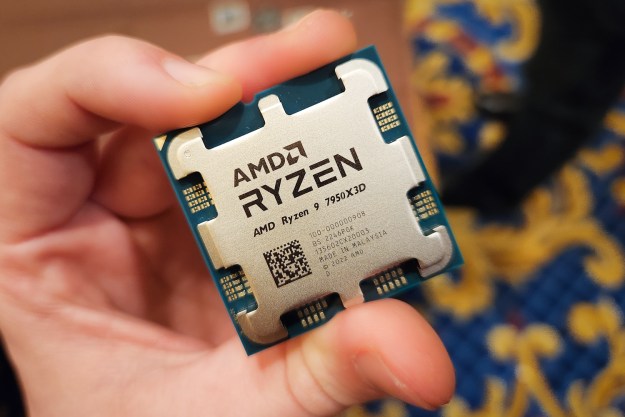New benchmarks for 10-core and 18-core Intel Cascade Lake X CPUs, the Core i9-10900X and 10980XE, have appeared on the Geekbench database and they’re strong performers. With 10 and 18 cores apiece, and double the thread support thanks to hyperthreading, they have single-threaded and multithreaded scores that are higher than even the supremely powerful, 28-core Intel Xeon W-3175X.
But none of that matters if AMD’s Threadripper 3000 CPUs prove to be as capable as their leaked benchmarks show. A new benchmark for a 32-core Threadripper 3000 “Sharktooth” CPU echoed earlier results with a single core and multicore score that takes a commanding lead over what the new Cascade Lake X chips are capable of.
AMD’s Threadripper CPUs have been nipping at Intel’s high-end desktop (HEDT) heels for several generations. The first-generation showed that high-core-count CPUs didn’t have to be expensive, and the second showed that stacking extra cores (up to 32 on the 2990WX) could give Intel’s faster, but lower-core-count chips a real run for their money.
But memory latency concerns held even AMD’s best Threadripper CPUs back from dominating in several benchmarks and real-world situations. A third-generation of Threadripper CPUs is expected to change that.

Based on the same Zen 2 architecture as the mainstream Ryzen 3000 chips, third-generation Threadripper processors should have the same major improvements in instructions per clock and memory efficiency, as well as a modest improvement in clock speed. All of that allowed the 32-core Threadripper chip, with its max turbo speed of 4.3Ghz, to hit a single-core score of 5,519 in the Geekbench results. In comparison, the 10-core Cascade Lake X processor, with its higher 4.4GHz clock speed, managed just 5,204, as per WCCFTech.
As for multithreaded performance, it’s a complete washout. The Threadripper 3000 chip achieved a score of 68,279 points, while the 10900X managed just 39,717. That’s a good score, and in-fact in excess of the 38,000 we’ve seen with the 28-core W-3175X, but it’s not a patch on the AMD offering.
That’s perhaps an unfair comparison, considering the core count differences. But a much closer competitor would be the high-end, Intel Core i9-10980XE. Its benchmark numbers, while closer, though, still fall behind the AMD alternative. First spotted by Twitter user @momomo_us on the Geekbench database, its single-threaded score was 5,381. Its clock speed hit a maximum of 3.93GHz, which suggests that the IPC of this chip is stronger than that of the Threadripper chip, but with a clock speed discrepancy, the Intel chip just couldn’t quite compete.
Its multithreaded score took quite a leap over the 10900X, hitting 51,514, but that’s still far behind the 32-core Threadripper.
Cascade Lake-X is designed to replace the existing Skylake-X lineup of 9000-series Intel HEDT chips. Since it’ll be based on a refined version of the same 14nm process, we don’t expect major improvements in its performance or capabilities and with the 10-core and 18-core variants looking very much like slightly tweaked versions of their ninth-generation counterparts, we expect to see 12, 14, and 16-core options available when Cascade Lake X debuts.
Typically, all Intel HEDT chips feature the same single-core boost clock, with all-core clocks being slightly higher on the chips with lower core counts. If that proves true with the 10-series Cascade Lake X chips, we wouldn’t expect any of them to have much greater single-threaded performance than we see here, barring a slight bump in clock speed over what is likely an engineering sample in this benchmark.
That puts AMD in a commanding position when it comes to next-generation workstation desktops. Both upcoming generations of Intel and AMD CPUs are expected to make their appearance before the end of the year, so they are likely to go head to head in the HEDT space. If that turns out to be true, though, the best performance per dollar will almost-certainly rest with AMD’s new Threadripper CPUs.
Intel wouldn’t be out of the running entirely, though. They will likely benefit from an expansive existing install base. Cascade Lake X is expected to be supported by existing X299 motherboards and the LGA 2066 socket, so an upgrade to the 10th generation will be cheaper than converting to AMD, even if the performance increase isn’t likely to be dramatic.
Updated September 20, 2019: Added benchmark results for the 18-core Intel Core i9-10980XE.
Editors' Recommendations
- Nice try, Intel, but AMD 3D V-Cache chips still win
- AMD’s new CPUs decisively end the high-performance battle with Intel
- These two CPUs are the only ones you should care about in 2023
- AMD Ryzen 9 7950X3D vs. Intel Core i9-13900K: only one choice for PC gamers
- AMD might finally beat Intel for the fastest mobile gaming CPU





